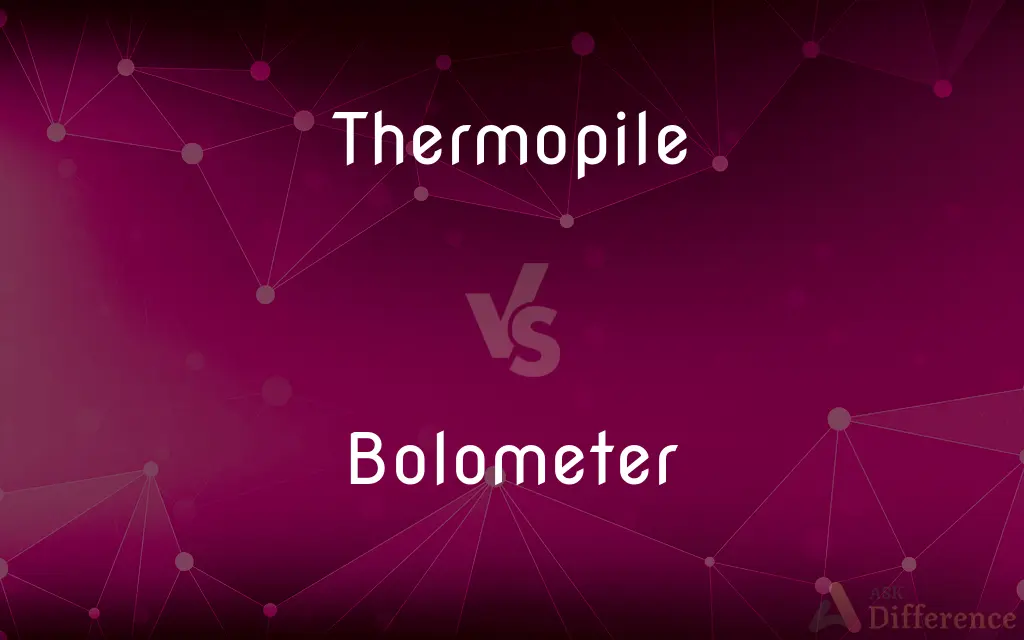Thermopile vs. Bolometer — What's the Difference?
By Maham Liaqat & Urooj Arif — Updated on March 8, 2024
Thermopile detects temperature differences via thermocouples, while a bolometer measures radiation intensity through absorption and resultant heat change.

Difference Between Thermopile and Bolometer
Table of Contents
ADVERTISEMENT
Key Differences
A thermopile is a device that consists of several thermocouples connected in series or parallel to measure temperature differences. Thermocouples, which are made from two different metals, generate a voltage when there is a temperature difference between their junctions. This makes thermopiles useful for non-contact infrared temperature measurements, such as in infrared thermometers and heat flux sensors. On the other hand, a bolometer is an instrument designed to measure the intensity of electromagnetic radiation, through the heating of a material with a temperature-dependent electrical resistance. When radiation is absorbed by the bolometer's sensitive material, its temperature rises, changing its resistance. This resistance change is then measured to determine the intensity of the incident radiation.
Thermopiles are characterized by their ability to generate electrical power from a temperature gradient, making them suitable for applications where remote sensing of heat is required without direct contact. They are widely used in various fields, including industrial temperature monitoring, gas leak detection, and environmental monitoring. Bolometers, however, are highly sensitive to changes in temperature and can detect not just visible light but also infrared and microwave radiation. This makes them particularly useful in astronomy for observing faint celestial objects, as well as in particle physics and materials science research.
The sensitivity of a thermopile depends on the number of thermocouples and the materials used to make them. The more thermocouples in a thermopile, the higher its sensitivity to temperature differences. In contrast, the sensitivity of a bolometer is influenced by the material's absorptive and thermal properties, as well as its ability to convert absorbed radiation into a measurable resistance change. Materials such as superconductors are often used in bolometers to achieve high sensitivity, especially in low-temperature environments.
In terms of operation, thermopiles operate by converting thermal energy into electrical energy, which can be easily measured. This operation is based on the Seebeck effect, where an electric circuit is formed by two dissimilar metals, and a voltage is generated at the junction of the metals when there is a temperature difference. Bolometers operate differently, relying on the change in resistance of a material when heated by absorbed radiation. This requires a constant current to be passed through the material, with the resistance change measured to infer the radiation's intensity.
Both thermopiles and bolometers are crucial in fields requiring precise temperature measurements and radiation intensity measurements, respectively. However, their principles of operation, sensitivity, and applications differ significantly, reflecting the diversity of methods available for measuring thermal and electromagnetic phenomena.
ADVERTISEMENT
Comparison Chart
Principle
Measures temperature differences via thermocouples
Measures radiation intensity through heat absorption
Sensitivity
Depends on the number of thermocouples
Depends on material's absorptive and thermal properties
Applications
Infrared thermometers, heat flux sensors
Astronomy, particle physics, materials science
Operation
Generates electrical power from temperature gradient
Measures resistance change due to temperature rise
Suitable for
Non-contact temperature measurements
Detecting faint electromagnetic radiation
Compare with Definitions
Thermopile
Comprises several thermocouples.
By using multiple thermocouples, the thermopile can detect very small temperature differences.
Bolometer
Highly sensitive to temperature changes.
Due to its high sensitivity, the bolometer requires shielding from extraneous thermal noise.
Thermopile
A device that converts thermal to electrical energy.
The thermopile sensor in the infrared thermometer accurately measured the patient's temperature without direct contact.
Bolometer
Operates based on material heating.
The absorbed radiation heats the bolometer element, changing its electrical resistance.
Thermopile
Used for remote sensing of heat.
Thermopiles in environmental monitoring stations help track heat flux without disturbing the habitat.
Bolometer
Measures radiation intensity via resistance changes.
The bolometer detected minute changes in cosmic microwave background radiation.
Thermopile
Suitable for industrial monitoring.
Thermopile sensors are key components in industrial systems for monitoring equipment temperatures.
Bolometer
Used in astronomy and physics.
Astronomers use bolometers to observe distant galaxies in the infrared spectrum.
Thermopile
Generates voltage from temperature gradients.
The thermopile generates a voltage signal that increases with the temperature difference.
Bolometer
Detects a wide range of radiation.
Bolometers are capable of detecting radiation from infrared to microwave frequencies.
Thermopile
A thermopile is an electronic device that converts thermal energy into electrical energy. It is composed of several thermocouples connected usually in series or, less commonly, in parallel.
Bolometer
(physics) A sensitive device for detecting and measuring the energy of electromagnetic radiation.
Thermopile
A set of thermocouples arranged for measuring small quantities of radiant heat.
Bolometer
A bolometer is a device for measuring the power of incident electromagnetic radiation via the heating of a material with a temperature-dependent electrical resistance. It was invented in 1878 by the American astronomer Samuel Pierpont Langley.
Thermopile
A device consisting of a number of thermocouples connected in series or parallel, used for measuring temperature or generating current.
Bolometer
An instrument that measures radiant energy by correlating the radiation-induced change in electrical resistance of a blackened metal foil with the amount of radiation absorbed.
Thermopile
(electronics) An electronic device that converts thermal energy into electrical energy. Usually constructed using a series-combination of thermocouples
Bolometer
An instrument for measuring minute quantities of radiant heat, especially in different parts of the spectrum; - called also actinic balance, thermic balance.
Thermopile
An instrument of extreme sensibility, used to determine slight differences and degrees of heat. It is composed of alternate bars of antimony and bismuth, or any two metals having different capacities for the conduction of heat, connected with an astatic galvanometer, which is very sensibly affected by the electric current induced in the system of bars when exposed even to the feeblest degrees of heat.
Bolometer
An instrument that measures heat radiation; extremely sensitive
Thermopile
A kind of thermometer for measuring heat radiation; consists of several thermocouple junctions in series
Common Curiosities
Why are bolometers important in astronomy?
Bolometers can detect extremely faint electromagnetic radiation, making them crucial for observing distant celestial objects that emit primarily in the infrared spectrum.
Can a thermopile measure absolute temperature?
Thermopiles measure temperature differences rather than absolute temperatures, requiring a known reference temperature for absolute measurements.
What makes a thermopile different from a single thermocouple?
A thermopile consists of multiple thermocouples connected together, enhancing its sensitivity and voltage output compared to a single thermocouple.
How does the environment affect a bolometer's performance?
Environmental factors, like temperature fluctuations and electromagnetic interference, can affect a bolometer's sensitivity and accuracy, necessitating careful shielding and calibration.
What materials are used in thermopiles?
Thermopiles use metals or semiconductors with differing Seebeck coefficients to maximize the voltage output from temperature differences.
Are thermopiles used in everyday devices?
Yes, thermopiles are commonly found in non-contact infrared thermometers, used in medical, cooking, and HVAC applications for quick and sanitary temperature measurements.
How does temperature affect bolometer sensitivity?
Lower temperatures generally increase bolometer sensitivity, as thermal noise decreases, allowing for more precise detection of radiation-induced resistance changes.
What advancements have been made in bolometer technology?
Recent advancements include the development of superconducting bolometers, which operate at very low temperatures to increase sensitivity to faint radiation signals.
Can thermopiles generate power?
Yes, thermopiles can generate a small amount of electrical power from heat sources, capitalizing on temperature differences to produce voltage.
How do you calibrate a bolometer?
Bolometers are calibrated using known radiation sources or temperatures, ensuring accurate measurements across different environmental conditions.
Share Your Discovery

Previous Comparison
Spy vs. Voyeurist
Next Comparison
Newsletter vs. NewspaperAuthor Spotlight
Written by
Maham LiaqatCo-written by
Urooj ArifUrooj is a skilled content writer at Ask Difference, known for her exceptional ability to simplify complex topics into engaging and informative content. With a passion for research and a flair for clear, concise writing, she consistently delivers articles that resonate with our diverse audience.














































